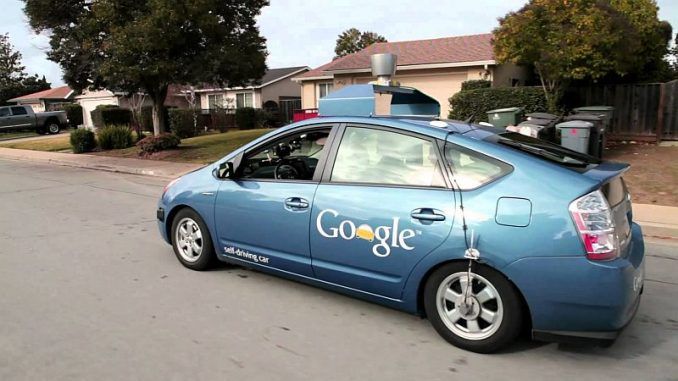
Human drivers are taking advantage of robot drivers who manage self driving cars.
The disciplined robots are programmed to be inconspicuous when they drive on Californian roads. They have been coded to be courteous, safe, and to stop if anything swerves in front of them. The automated chauffeurs have software code implanted in their generics that humans are impatient, risk-taking and superior to robots. As more people get accustomed to self driving cars on Californian roads they are also learning about the timid nature of the nameless, faceless and characterless “robot” drivers. Knowing full well that the robots will never cut them off, give them dirty looks as they overtake them, or conduct themselves in bouts of ‘road rage’, some superior humans are now beginning to take advantage of the situation, and would like to see more driver-less cars at the hands of robots on the roads of California.
Fastcoexist reports:
“Google cars drive like your grandma,” writes a reader of Wearobo. “They’re never the first off the line at a stop light, they don’t accelerate quickly, they don’t speed, and they never take any chances with lane changes (cut people off, etc).”

BYPASS THE CENSORS
Sign up to get unfiltered news delivered straight to your inbox.
You can unsubscribe any time. By subscribing you agree to our Terms of Use
This is great, not only for other drivers, but for pedestrians and cyclists too. Self-driving cars work hard to keep everyone safe, not just their occupants. They wait until the last pedestrian has crossed the street before moving off. They back off if you pull in too hard after overtaking. In short, they’re easy marks that other drivers can exploit. Here’s an account from the same anonymous writer:
Once, I got a little caught out as the traffic transitioned from slow moving back to normal speed. I was in a lane between a Google car and some random truck and, partially out of experiment and partially out of impatience, I gunned it and cut off the Google car sort of harder than maybe I needed too… The car handled it perfectly (maybe too perfectly). It slowed down and let me in. However, it left a fairly significant gap between me and it. If I had been behind it, I probably would have found this gap excessive and the lengthy slowdown annoying. Honestly, I don’t think it will take long for other drivers to realize that self-driving cars are “easy targets” in traffic.
One day, all cars will be self-driving, but until that day—when humans can text and do their lipstick and prepare their breakfast on their commute like they do today, only safely—the roads will carry mixture of self-driving and human-driven vehicles. And as the proportion of self-driving cars increases, the gains to be had in gaming them increase.
Imagine a world where you are the only driver, and all other cars drive themselves. You could do anything—run lights, hurtle the wrong way down the freeway, pull out into traffic without looking—and you’d be safe. The self-driving cars would swerve, slow or stop to let you through. And if the standard behavior of human drivers is anything to go by, we will be merciless.
You won’t be surprised to learn that, of the 12 accidents that involved Google’s cars during the six years of the project, all were caused by humans. “During more than 1.8 million miles of autonomous and manual driving combined, not once was the self-driving car the cause of the accident,” says a report from Google.
It seems unlikely that human-piloted cars will ever be banned from roads. Even if we try, it would be decades before all today’s perfectly serviceable cars are replaced through the regular upgrade cycle.
So how will the roads look as we transition to driverless cars? We humans naturally push our advantages whenever society lets us get away with it, and society lets us behave disgracefully when we’re driving. And right now, as Google’s cars react to our hair-raising maneuvers, the self-driving cars might draw the ire of other drivers.

But as the proportion of manually-driven journeys drops, then perhaps aggressive driving will go the way of smoking in public, or drinking and driving, both of which used to be just fine. Ferrari owners will have to take them to the track if they want to squeal their tires and rev their engines (or they could buy a self driving BMW which pipes fake engine noise into the passenger cabin).
Imagine yourself in the future. You’re in your comfy electric Google car, cruising along to work in a quarter of the time it takes you now because there are no traffic jams, no traffic lights, and no accidents. You and all the other self-driving cars on the road work together to route vehicles through the city like packets of information routed through the Internet.
Now, a human driver careens out onto your street, cutting through the placid convoy. You spill your latte onto your Kindle as your Google car brakes to avoid a collision, and the effects ripple down the street as the other robot cars slow or swerve. You feel road rage, but there’s nothing you can do.
The next time you’re at a dinner party, or out at a bar with friends, and you learn that one of the group is a human driver, what do you do? You’ll ostracize them, of course, because that’s our best tool to effect social change.
Edmondo Burr
CEO
Assistant Editor
Latest posts by Edmondo Burr (see all)
- Police Arrest Suspect In Supermarket Baby Food Poisoning - October 1, 2017
- Seoul Secures Data From Electromagnetic Interference By N Korea - September 30, 2017
- The ‘World’s First Internet War’ Has Begun: Julian Assange - September 30, 2017


Be the first to comment